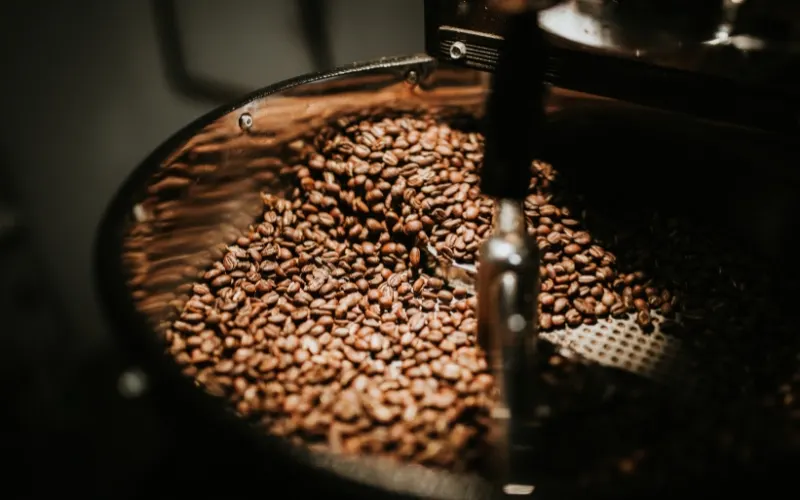
Egyptian Coffee Roasting Techniques
10 June، 2025
At Ben El-Abed, we don’t just sell coffee—we preserve a legacy and continue to evolve it. Our Egyptian coffee roasting methods are the result of years of expertise, blending tradition with innovation. In this article, we take you on a journey through the secrets of traditional roasting, modern techniques we use at Ben El-Abed, and how roasting shapes the flavor of your perfect cup.
Roasting: The Most Critical Step in the Coffee Journey
Roasting is the magical transformation that turns green coffee beans into aromatic brown treasures bursting with flavor. There are countless secrets in roasting, and every roaster has their unique signature. In Egypt, coffee roasting is a time-honored craft that has evolved from traditional techniques to cutting-edge innovations.
“Roasting isn’t just a step in coffee preparation—it’s a craft, a science, and an intuition.” – Ben El-Abed
Traditional Egyptian Roasting Techniques
Traditional Egyptian roasting carries a charm of its own. For generations, coffee was roasted in homes and small shops using simple, yet effective tools.
The Copper Pan Roaster (“Al-Tasa”)
The copper pan, or “Al-Tasa,” is a traditional tool still used in roasting today. It’s a flat copper vessel with a long handle, placed over a low flame while the beans are stirred constantly for even roasting.
This method offers:
- Full control over roast levels
- Slow roasting that preserves nuanced flavors
- The option to infuse cardamom or cinnamon for Arabic-style coffee
The Clay Oven
In parts of Upper Egypt, coffee was roasted in traditional clay ovens. The even heat of the clay oven produces a consistent roast and imparts a distinctive earthy flavor.
Rotating Charcoal Roasters
By the early 20th century, rotating charcoal roasters began appearing in specialty coffee shops. These roasters featured a rotating metal drum over glowing charcoal, ensuring uniform heat distribution and consistent roasting.
Modern Roasting Techniques: Evolving Without Losing Tradition
With advances in technology, coffee roasting techniques have evolved—blending scientific precision with the soul of traditional craftsmanship.
Hot-Air Coffee Roasting
At Ben El-Abed, we proudly use hot-air roasting technology. This European method involves circulating hot air around the beans rather than exposing them directly to flame.
The Benefits of Hot-Air Roasting:
- Even roasting for every single bean
- Reduced acidity and bitterness
- Preserves the bean’s natural flavor profile
- Lowers acrylamide levels (a potentially harmful compound in traditional roasting)
- Precise control over temperature and roast time
Drum Roasting
A popular method in large-scale roasteries, it uses a rotating drum heated from the outside. It allows for roasting large batches evenly, with excellent control over both temperature and roast duration.
Direct Flame Roasting
Some modern roasters use direct flame to heat the beans. This method gives coffee a bold, intense flavor—but it requires great skill to avoid burning the beans.
Coffee Roast Levels: A Flavor for Every Preference
Different roast levels unlock different flavor profiles. Each is suited to a specific brewing style—and a specific palate.
Light Roast (Cinnamon Roast)
Light Roast: Light roasts, also known as cinnamon roasts, are pale brown and preserve the coffee’s original taste—with bright acidity and notes of fruit and flowers. Ideal for filter coffee and pour-over brewing methods.
Light Roast Characteristics:
- Pale brown color, cinnamon-like hue
- Dry bean surface (no oil)
- Clear fruity acidity
- Higher caffeine content
Medium Roast
The most popular roast in Egypt, medium roasts strike a perfect balance between natural bean flavors and roast notes. Great for Turkish coffee, espresso, and French press.
Medium Roast Characteristics:
- Medium brown color
- Slight oil presence on the bean surface
- Balanced acidity and bitterness
- Notes of chocolate, nuts, and caramel
Dark Roast
Dark roasts are deep brown, offering bold flavors of dark chocolate and caramel with a touch of bitterness. Best suited for strong Turkish coffee and espresso.
Dark Roast Characteristics:
- Dark brown, nearing black
- Oily, glossy surface
- Robust flavor with low acidity
- Full-bodied with a creamy mouthfeel
Italian Roast (Very Dark)
Italian roasts are the darkest of all, with an almost black color and bold, slightly bitter flavor. Perfect for traditional Italian espresso.
Italian Roast Characteristics:
- Very dark brown, nearly black
- Extremely oily surface
- Smoky, caramelized sweetness
- Extra heavy body with pronounced bitterness
How Roasting Affects Coffee Flavor: The Science Behind the Art
Roasting has a tremendous impact on the flavor profile of coffee. During roasting, complex chemical reactions take place inside each coffee bean, transforming its composition and producing hundreds of aromatic compounds that define its unique flavor.
Chemical Reactions During Roasting
- Maillard Reaction: A reaction between sugars and amino acids that produces browning and rich aromatic compounds.
- Sugar Caramelization: Natural sugars caramelize, contributing to sweet flavors and darker tones.
- Moisture Evaporation: Moisture escapes from the beans, causing them to expand and crack.
- CO2 Release: Carbon dioxide builds up inside the beans and continues to be released days after roasting.
Factors That Influence Roast Quality
- Temperature Control: Precise heat regulation ensures an even roast.
- Roasting Time: Slower roasting allows deeper flavor development.
- Constant Agitation: Helps ensure every bean is roasted evenly.
- Rapid Cooling: Quickly halting the roast locks in the desired profile.
- Bean Quality: No roasting method can compensate for poor raw beans—quality starts at the source.
Home Roasting: The Art Within Reach
Roasting coffee at home can be a fun and rewarding experience. While the outcome may not match professional roasteries, it’s a great way to explore the craft and experiment with roast levels.
Basic Tools for Home Roasting
- Pan Roasting: A basic skillet over low heat with constant stirring.
- Oven Roasting: Beans can be roasted in a tray, stirred regularly to ensure evenness.
- Home Roasters: Specialized small appliances designed for roasting at home, offering various features and price points.
Tips for Better Home Roasting
- Start small—about 100g is ideal for control.
- Use low heat and stir consistently.
- Listen for the first and second “cracks” to gauge roast stage.
- Prepare a wide bowl for immediate cooling.
- Let the beans rest 12–24 hours before grinding and brewing.
Preserving Coffee Quality After Roasting
Roasting isn’t the final step—how coffee is stored afterward is just as crucial to flavor and freshness.
Packaging and Storage
At Ben El-Abed, we use airtight packaging with one-way valves that release CO2 while keeping oxygen out. This preserves the coffee’s freshness and flavor for longer.
Tips for Storing Roasted Coffee:
- Use airtight containers
- Store away from light, heat, and moisture
- Avoid refrigeration—it absorbs odors
- Buy only a 2–3 week supply at a time
- Grind just before brewing
Ben El-Abed Roasting Technology: Distinction Meets Innovation
At Ben El-Abed, we blend traditional mastery with the latest global roasting innovations. Our European-style hot-air roasting technology is the result of years of research and refinement—guaranteeing a consistently exceptional coffee experience in every cup.
Why Ben El-Abed’s Roasting Stands Out
- Selective Sourcing: We handpick the finest beans from their original regions, rejecting anything less than perfect.
- Hot-Air Roasting: Our process preserves the bean’s flavor and reduces bitterness and acidity.
- Precision Control: Our roasters are equipped with advanced systems to manage heat and time with accuracy.
- Rapid Cooling: Beans are immediately cooled to lock in optimal flavor.
- Fresh Delivery: We make sure every bag reaches you as fresh as it left our roaster.
- Versatile Roast Profiles: From light to dark, we offer roast levels to match every brewing method and taste.
Frequently Asked Questions About Coffee Roasting
What’s the Best Way to Roast Coffee?
There’s no single “best” method—it depends on preference. Hot-air roasting offers consistency and precision, while traditional methods provide bold, nostalgic flavor.
How Does Roasting Affect Coffee Flavor?
Roasting has a major impact on flavor. Light roasts retain fruity acidity and natural taste, while dark roasts offer bold chocolate and caramel notes with slight bitterness.
What’s the Difference Between Traditional and Modern Roasting?
Traditional roasting relies on skill and intuition, often using basic tools like copper pans or clay ovens. Modern roasting is tech-driven, featuring advanced machines that allow for meticulous temperature and timing control.
How Do I Choose the Right Roast for Me?
Your ideal roast depends entirely on your personal taste and how you brew your coffee:
- If you enjoy fruity brightness, go for a light roast.
- For a balance of sweetness and acidity, try medium roast.
- Prefer bold coffee with deep cocoa notes? Dark roast is for you.
Can I Roast Coffee at Home?
Yes—you can roast coffee at home using basic tools or a home roaster. However, it takes practice and patience—and results may not rival those of a professional roastery.
In Conclusion…
Egyptian coffee roasting is a blend of art, science, and heritage. At Ben El-Abed, we unite timeless traditions with modern methods to bring you an exceptional coffee experience in every cup.
From sourcing premium beans to hot-air roasting, packaging, and fresh delivery—every step is fueled by love, passion, and expertise. That’s why our coffee is more than a drink—it’s a sensory journey.
Visit your nearest Ben El-Abed branch and enjoy an authentic Egyptian coffee experience—roasted by the hands of happiness.
Ben El-Abed… We Work Hard So You Stay Awake
Enjoyed this article? Share it with your fellow coffee lovers, and follow us on social media for more insights and tips from the coffee world.
Explore Our Coffee Collection | Chat with Our Coffee Experts | Talk to Our Coffee Experts





